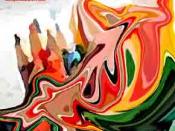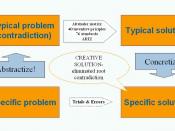1 Introduction
We all possess the ability to think creatively. As human animals, we are born with come creative thinking abilities - it is in our biological makeup to create - but we probably acquired most of our higher levels of creativity. That is, the creative problem solving abilities we use to solve other than day-to-day problems are most likely learnt. Through training, we have learnt to respond to certain situations by custom designing our responses, creating solutions for non-routine situations (Vangundy, 1992)).
2 What is Creativity?
"Creativity is a process of developing and expressing novel ideas that are likely to be useful" (Swap & Leonard, 1999, pp.6)
Within this definition, there are 4 features. Firstly, creativity involves divergent thinking - a breaking away from familiar, established ways of seeing and doing things (breaking away from paradigms). Secondly, these novel ideas must be expressed or communicated to others. This expression provides a reality check on whether the ideas are really novel - or simply bizarre.
Thirdly, creativity must also include convergent thinking - some agreement that one or more of the novel ideas is worth pursuing. Finally, this agreed-on option must have the potential for being useful and for addressing the problem that initiated the development of options. The end result of the creative process is an innovation:
"Innovation is the embodiment, combination, and/or synthesis of knowledge in novel, relevant, valued new products, processes or services" (Swap & Leonard, 1999, pp.7)
3 Types of Thinkers
"It is not enough to have a good mind. The main thing is to use it well"
(Henry, 1992, pp. 25)
The way in which the managers and employees of an organisation think will have a great influence over the organisations daily business, the way problems are solved, and how changes and transitions are managed.



Creativity
I'm appreciative of your good essay on creativity in management. As business becomes increasingly competitive, it will be more important than ever that managers formulate innovative strategies to ensure that their organizations succeed. You used headings well and that made your paper easy to read. Your report was well documented and researched. Nice work!
5 out of 5 people found this comment useful.